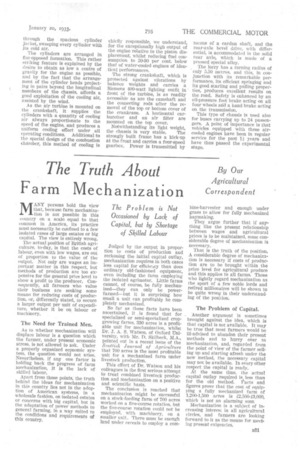The Truth About
Page 45

If you've noticed an error in this article please click here to report it so we can fix it.
Farm Mechanization
By Our Agricultural Correspondent
MANY persons hold the view that, because farm mechanization is not possible in this country on a scale equal to that common in America, its practice must necessarily be confined to a few isolated cases of large estates or big capital. The view is entirely wrong.
The actual position of British agriculture, to-day, is that the costs of labour, even with low wages, are out of proportion to the value of the output. Not only are wages an important matter in this respect, but methods of production are too expensive for the general price level to show a profit to the producer. Consequently, all farmers who value their business are seeking some means for reducing costs of production, or, differently stated, to secure a larger output per unit of expenditure, whether it be on labour or ma chinery.
The Need for Trained Men.
As to whether mechanization will displace labour is a question which the farmer, under present economic stress, is not allowed to ask. Under a properly organized economic system, the question would not arise. Nevertheless, if any one factor is holding back the progress of farm mechanization, it is the lack of skilled labour.
Apart from those points, the truth behind the ideas for mechanization in this country lies not in the adoption of American systems. in a wholesale fashion, on isolated estates or concerns with big capital, but in the adaptation of power methods to general farming, in a way suited to the conditions and requirements of this country.
Judged by the output in proportion to costs of production and reckoning the initial capital outlay, mechanization requires in both cases less capital for efficleacy than does ordinary old-fashioned equipment, even including the farm employing the isolated agrimotor. Little farms cannot, of course, be fully mechanized—they can only be powerfarmed—but it is surprising how small a unit can profitably be completely mechanized.
So far as these facts have been ascertained, it , is found that for specialized or semi-specialized cropgrowing farms, 380 acres is a profitable unit for mechanization, whilst Dr. J. A. S. Watson, of Oxford University, with Mr. D. Skilbeck, M.A., pointed out in a recent issue of the Scottish Journal of Agriculture that 700 acres is the most profitable unit for a mechanized farm under livestock production.
This effort of Dr. Watson and his colleagues is the first serious attempt to treat combined livestock production and mechanization on a positive and scientific basis.
The conclusion is reached that mechanization might be successful on a stock-feeding farm of 700 acres worked on a five-course rotation, but the five-course rotation could not be employed, with machinery, on a smaller unit., 'There must be enough land under cereals to employ a corn
bine-harvester and enough under grass to allow for fully mechanized haymaking.
They argue further that if anything like the present relationship between wages and agricultural prices is to be maintained, some considerable degree of mechanization is necessary.
That is the truth of the position. A considerable degree of mechanization is necessary if costs of production are to be brought within the price level for agricultural produce and this applies to all farms. Those who lightly regard mechanization as the sport of a few noble lords and retired millionaires will be shown to be quite wrong in their understanding of the position.
The Problem of Capital.
Another argument is sometimes brought against the idea, which is that capital is not available. It may be true that most farmers would be ill-advised to abandon their present methods and to hurry over to mechanization, and, regarded from the point of view of the farmer selling up and starting afresh under the new method, the necessary capital niay not be available. In every other respect the capital is ready.
At the same time, the actual capital outlay required is less than for the old method. Facts and figures prove that the cost of equipping a fully mechanized farm of 1.200-1,500 acres is 12,500-13,000, which is not an alarming sum..
Mechanization is a subject of increasing interest in all agricultural circles, and farmers are looking forward to it as the means for meeting present exigencies.




























































































